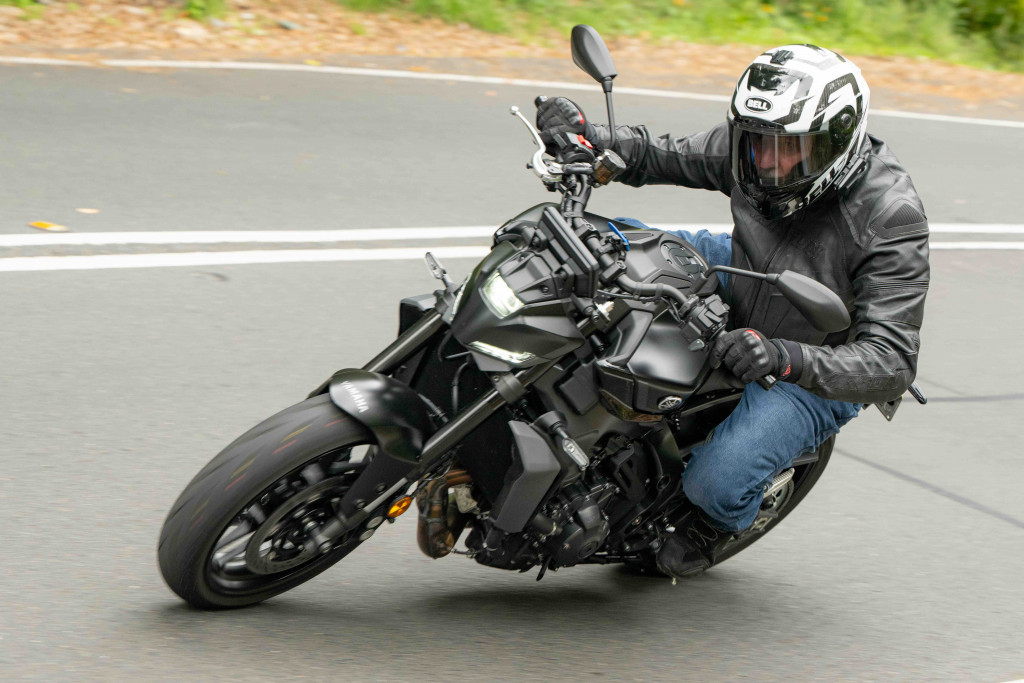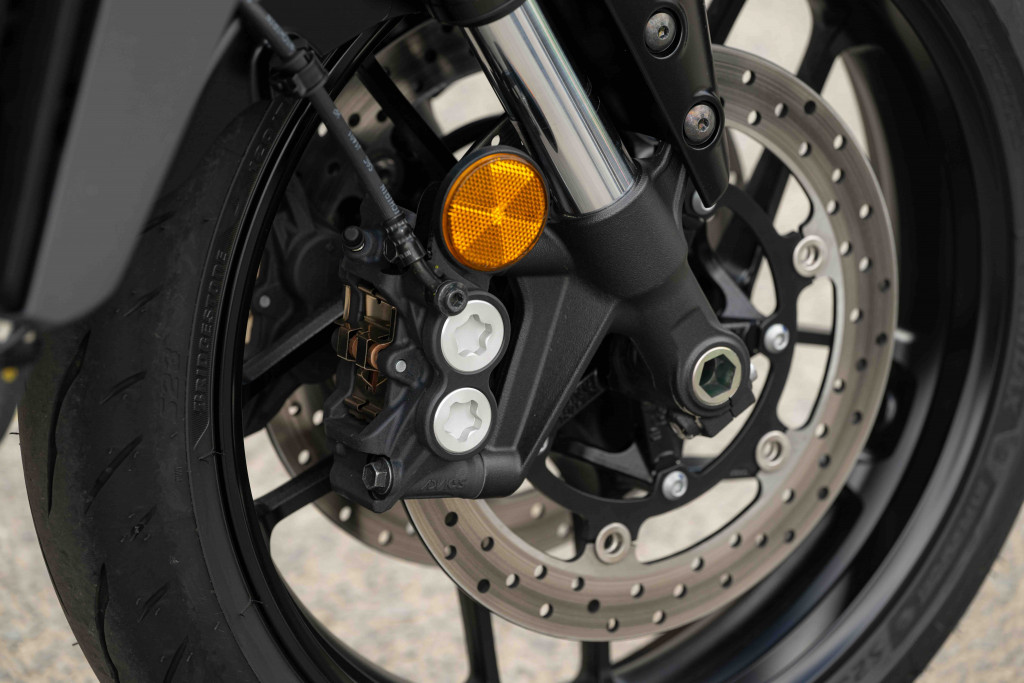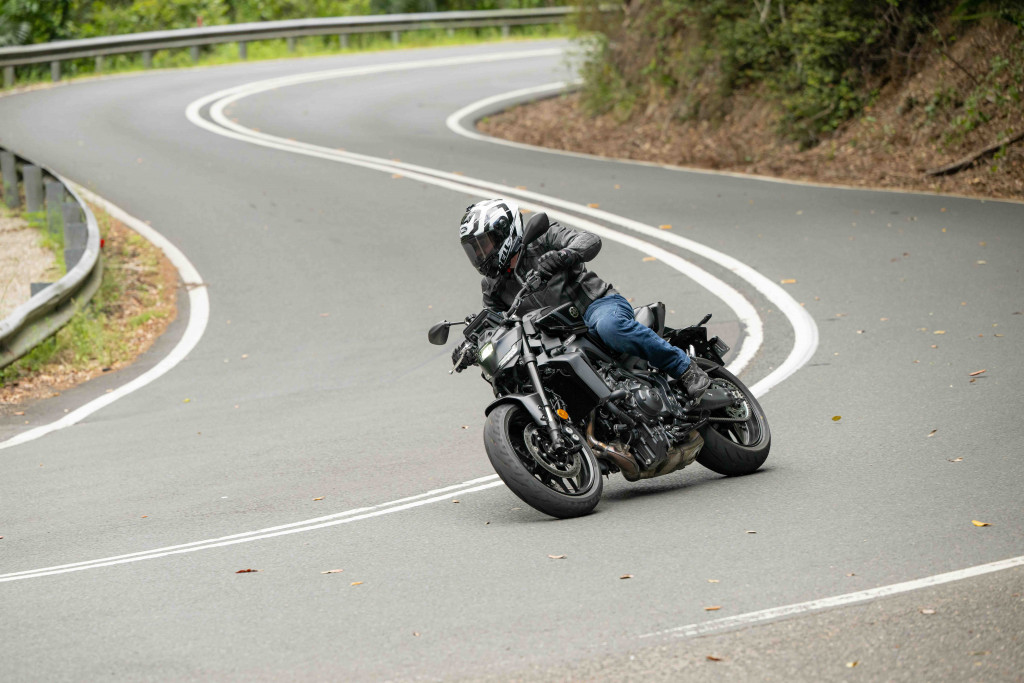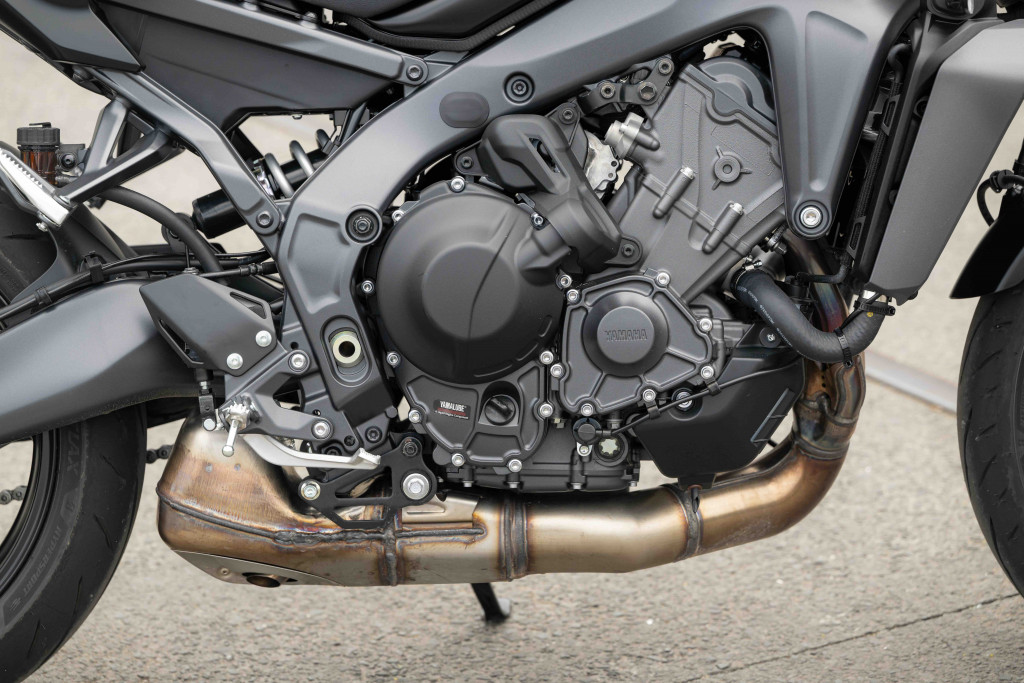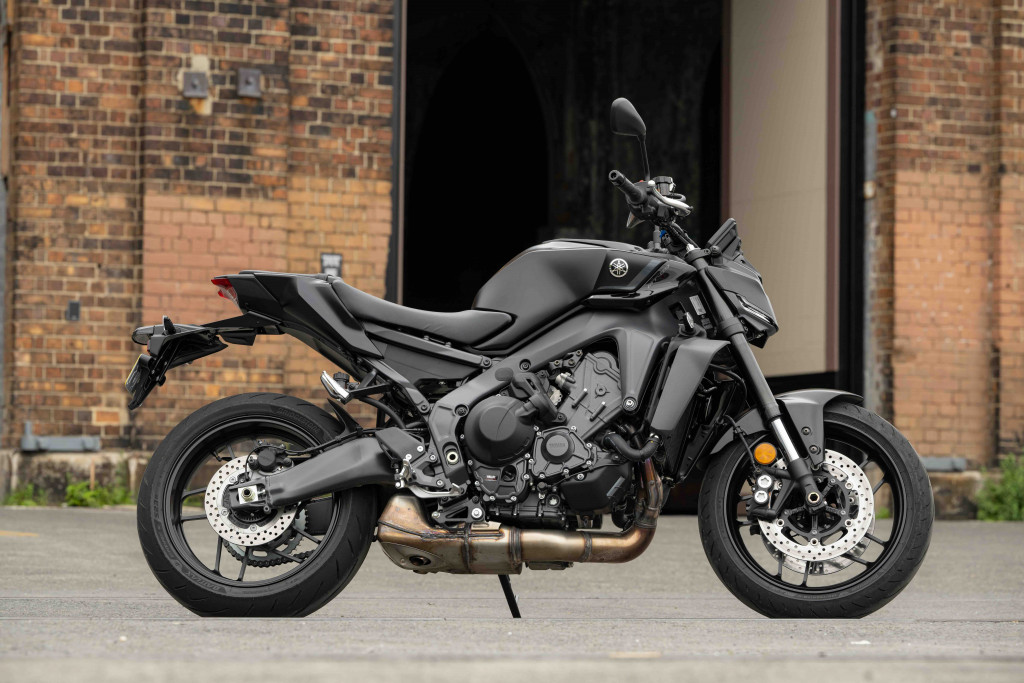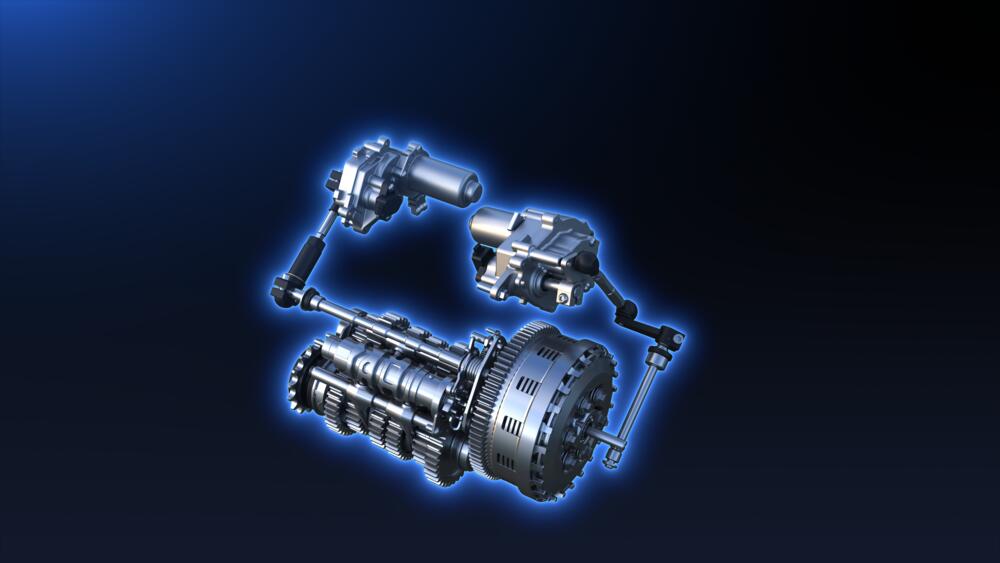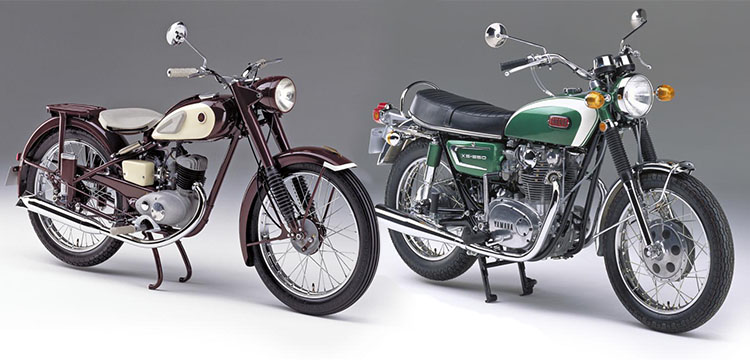
We test the Yamaha MT-09 AMT to find out if auto shifting detracts from the joy of riding a motorcycle
There is something special about this Yamaha MT-09. It might look like any other MT-09, with its minimalist angular bodywork and compact LED headlight in that Darth Vader-like cowling, but what makes it special are the bits that are missing. Look a little closer and you’ll see there’s no clutch lever and no gear lever…
That’s because this is the new Yamaha MT-09 AMT, which represents the manufacturer’s first foray into the world of self-shifting gearboxes on motorcycles. While this would suggest it features an automatic transmission, AMT actually stands for Automated Manual Transmission, which may sound like an oxymoron if ever there was one. But in this case, ‘Automated Manual’ is an apt description, because the MT-09 AMT runs the same gearbox as the manual MT-09, with the automated bit courtesy of the clutch and gear shift each being actuated by electric motors, eliminating the need for both the clutch lever and the foot-operated gear shifter. Gear shifting can be looked after ‘automatically’ in either the ‘D’ mode or the sportier ‘D+’ mode, or ‘manually’ via a seesaw switch on the left switchblock.
Of course, automatic shifting is nothing new on motorcycles, with Honda’s Dual Clutch Transmission (DCT) system introduced well over a decade ago on the VFR1200F, and now proving popular on models like the GoldWing and NT1100 tourers, the CMX1100 cruiser and the Africa Twin adventure bike. But automatic shifting like the system on this MT-09 AMT is new for Yamaha, and when we tested the bike, the manufacturer was testing the waters in Australia, initially bringing in just 30 to 40 units to see what sort of demand is out there in the marketplace.
After riding the MT-09 AMT, I reckon there could quite a few riders interested in this technology… and the AMT system is set to be introduced to other models in the Yamaha range in the not-too-distant future.
THE YAMAHA MT-09 AMT IS NOT THAT DIFFERENT
Other than the fact it’s equipped with an automated manual transmission, the MT-09 AMT is essentially the same bike as the manual MT-09… right down to the $17,399 ride-away price. That means it’s powered by the same CP3 890cc inline triple engine that makes a claimed 87.5kW (113hp) at 10,000rpm and 93Nm at 7000rpm, mated to a six-speed gearbox and with chain final drive.
The engine is housed in a die-cast aluminium Deltabox frame and the MT-09 runs fully adjustable KYB suspension front and rear, with a 41mm USD fork at the pointy end and a monoshock in the rear. Wheels are lightweight spin-forged items wearing Bridgestone Battlax Hypersport S2 rubber with a 120/70ZR17 up front and a 180/55ZR17 on the rear.
The front brakes feature a Brembo radial master cylinder with four-piston radial-mount calipers gripping twin 298mm discs, while there’s a single-piston caliper at the back and a 245mm disc. A six axis IMU allows for the use of cornering ABS and traction control, and other rider aids include slide control, front wheel lift control and a back slip regulator, the latter to prevent rear wheel lock when downshifting. Cruise control is standard too.
THE YAMAHA MT-09 AMT ON THE ROAD
As I lined up the MT-09 AMT with the ramp to load it into my van at Yamaha’s Sydney HQ, I was concerned by the lack of a clutch lever. To get rolling, you simply select first gear with a tap on the ‘+’ seesaw switch on the left switchblock and wind on the throttle, but would the automated system have the finesse to feather the clutch as I walked the bike up the ramp? I needn’t have worried; the electric motor operating the clutch seemed to know exactly what I was up to. There was no sudden engagement or lurching and as soon as I rolled the bike into the wheel chock and backed off the throttle, the clutch automatically disengaged.
This simple twist-and-go from a standstill makes quick getaways from the lights a doddle, and if you’re in either of the auto modes, you don’t have to think about when to snick into the next gear; just open the throttle and keep an eye on the speedo. In either ‘D’ mode or ‘D+’ mode, the system will adapt to your riding style, short shifting if you’re on partial throttle and not in a hurry, but holding on to gears for longer with wider throttle openings. The ‘D+’ mode holds on to gears for longer for a sportier riding experience, although there’s not a huge difference between it and the ‘D’ mode.
You can select either of the auto modes, or manual shifting, via a button on the right switchblock. Once in manual, you simply shift gears via the ‘+’ and ‘-’ seesaw switch on the left switchblock, using your forefinger (pull to upshift and push to downshift) or your forefinger and thumb. At first I had to really think about which way to tap the seesaw switch, and on occasion I downshifted instead of upshifted, so was thankful that the back slip regulator did its job when I accidentally shifted down to first instead of up to third, but after a couple of days riding the AMT, it started to feel as natural as shifting with a foot-operated gear lever.
Performance-wise, there’s not much to pick between the AMT version of the MT-09 and the manual version, although Yamaha says there are advantages with the Automated Manual Transmission: “Shifting by hand alone, as opposed to a foot-and-hand combination, is not only quicker, but requires less thinking time, allowing the rider to hyper-focus on throttle and brake application, lean angle, body position and tyre grip levels to intensify the ride, especially in cornering.” I’m not so sure if my hands work quicker than my feet, but one definite advantage of the AMT is your foot doesn’t get in the way when cranked over in left-hand corners and wanting to change gears, because you can leave your toes up on the footpeg.
The MT-09 AMT is equipped with the same selectable ride modes as the manual variant, which means you can choose between Rain, Street, Sport and two Custom modes, or delve into the settings further and tailor each mode to suit your preferences. Variable parameters include the lean-sensitive three-level traction control (TCS), Slide Control System (SCS), Brake Control System (BC) and Back Slip Regulator (BSR), and once you have them at the levels you want, you can assign them to either of the Custom modes for easy selection via the mode switch. It should be noted that if you switch off the Front Wheel Lift Control System (LIF), it will remain off in all modes until you switch it back on again.
And what about wheelies, you ask? With LIF switched off, just crack the throttle open in first gear and the front end will loft straight away. In fact, with an abundance of torque down low and throughout the midrange, the front wheel can get quite flighty in second and third gears when accelerating hard out of corners; for day-to-day riding, it’s a good idea to leave LIF switched on.
You might think that automated shifting would detract from the riding experience, but that fabulous CP3 inline triple ensures this MT-09 still has plenty of character and is still a blast to ride. The engine is a pearler, pulling hard throughout the rev range and making a satisfying howl while doing it. The MT-09’s airbox is equipped with acoustic amplifier grilles in the top of the fuel tank that enhance induction roar, and combined with the exhaust note, the bike sounds great from the rider’s perspective.
The exhaust doesn’t have a traditional end-can muffler, but rather a system that is packaged under the bike with dual outlets either side of the rear wheel. While this means there’s a sizeable lump of metal positioned under the bike, it also frees up the view down both sides of the MT-09, showing off the beautifully sculpted swingarm and giving the rear end a tidy, uncluttered appearance.
The MT-09 AMT is a compact bike with an accessible 825mm seat height and an upright riding position that is well suited to commuting duties. The handlebar is the widest part of the bike, which makes filtering through traffic easy, and weighing in at just 196kg wet (only 3kg more than the manual variant) it is easy to manoeuvre at low speeds. But the MT-09 is much more than just an around-town bike…
Get out on the open road and the light, flickable chassis makes the MT-09 a hoot through the twisties. The wide-ish handlebar makes it easy to throw it on its side and aids quick changes of direction, but it doesn’t feel at all nervous and will hold a line well when cranked over. The standard suspension settings worked well for my 76kg plus riding gear, but if you feel the need to tweak it to suit your weight and riding style, there’s preload adjustment front and rear, as well as compression and rebound damping adjustment at both ends. Part of this test was over some pretty chopped-up back roads and suspension compliance was impressive.
The Bridgestone Battlax Hypersport S23 M tyres – a 120/70ZR17 up front and a 180/55ZR17 at the rear – offer loads of dry-weather grip and inspire plenty of confidence when riding hard. Although I didn’t cop any inclement weather on this test, I have ridden with these tyres in the wet on previous occasions and can vouch for their effectiveness.
While there is no branding on the radial-mount front-brake calipers, the MT-09 is equipped with a Brembo master cylinder and the setup provides plenty of stopping power and good feel at the span-adjustable lever. The rear brake is likewise more than satisfactory. When you start braking and come to a stop, the AMT system automatically downshifts and then disengages the clutch, so you can focus solely on braking. Of course, this might not seem like much of a big deal to seasoned motorcyclists, but it’s certainly convenient, especially when riding around town in stop-start traffic.
THE YAMAHA MT-09 AMT IS WELL EQUIPPED
As well as its fully adjustable KYB suspension, the MT-09 AMT is equipped with standard cruise control and Yamaha’s Smart Key System. The cruise control is easy to use and does a good job of maintaining set speed, while the smart key means no more fumbling through your pockets looking for a physical key after you’ve put your gloves on. And unlike some other smart key systems, you don’t need a physical key to unlock the fuel cap; it unlocks automatically when you switch the ignition off, and locks again when you engage the steering lock.
A full-colour 5-inch TFT screen with smartphone connectivity and navigation clearly shows all the major information you need when riding, such as digital speedo, bar-graph tacho, gear-position indicator and fuel level, but despite selectable themes, some secondary readouts are a bit small for those of us who need reading glasses. Having said that, it’s easy to navigate through the various functions and settings, and you can adjust Yamaha Ride Control (YRC) settings via the myRide app.
When it comes to accommodation, the MT-09 is a compact machine, but the adjustable handlebar and footpegs allow riders to tailor the riding position to suit them. The rider’s seat is wide and supportive where it needs to be, and the kick-up at the rear stops you from sliding back under hard acceleration. The pillion seat is on the small side, and there’s not a lot to grab hold of back there, but I had no problem securing a bag to the back with a couple of tie-down straps.
The 14-litre fuel tank is on the small side, but on test I recorded a respectable average fuel consumption figure of 4.6L/100km, so you might be able to eke out 300km between refills.
VERDICT
I think one of the most surprising things about the Yamaha MT-09 AMT is that it costs the same as the manual variant, which itself is excellent value for money at $17,399 ride away, especially when you consider the performance and versatility it offers, as well as its fully adjustable suspension and impressive suite of electronic rider aids. And the AMT even scores the smart key system, which was previously only offered on the top-spec MT-09 SP.
After spending a couple of weeks with the MT-09 AMT, I think Yamaha Australia is being a little conservative regarding potential demand for this bike, but it will have to get bums on seats to prove to riders how good it is. Would I buy the AMT over a manual MT-09? If it was my only bike and I was going to use it for commuting as well as weekend rides, I reckon I might consider it.
HOW DOES Y-AMT WORK?
With Y-AMT, the process of operating the clutch with your left hand and the gear lever with your left foot is automated: actuators handle both clutching and shifting, so you get the ease of automation without sacrificing that classic, satisfying manual feel.
When you shift gears, the bike’s engine control unit (ECU) and motor control unit (MCU) team up to manage the actuators. The ECU tweaks engine ignition and fuel injection on upshifts and adjusts the electronic throttle when downshifting, while the MCU guides the actuators for the best possible clutch and shift action.
To keep things optimal even at high engine revs, the clutch isn’t fully disengaged when it’s not necessary. A spring in the shift rod speeds up shift times, and with the ECU and clutch working together, Y-AMT delivers quick, almost shock-free shifts that feel smooth and natural. Having said that, shift quality can be a little harsh at partial throttle openings, and the system doesn’t always pick the gear you might want, but you can override this with the seesaw switch at any time.
The overall weight of the Y-AMT system is just 2.8kg and its compact design minimises the impact on bike styling and handling characteristics.
SPECIFICATIONS
ENGINE
Type: Liquid-cooled in-line triple-cylinder, DOHC, four valves per cylinder
Capacity: 890cc
Compression ratio: 11.5:1
Engine management: Mikuni EFI
PERFORMANCE
Claimed maximum power: 87.5kW (117hp) @ 10,000rpm
Claimed maximum torque: 93Nm @ 7000rpm
Fuel consumption: 4.6L per 100km (measured)
TRANSMISSION
Type: Constant-mesh 6-speed gearbox with automated manual shift
Final drive: Chain
Clutch: Wet, multi-plate, slipper
CHASSIS AND RUNNING GEAR
Chassis: Aluminium twin-spar frame
Front suspension: KYB 41mm USD fork, fully adjustable, 130mm of travel
Rear suspension: Double-sided swingarm with monoshock, fully adjustable, 130mm travel
Front brakes: Twin 298mm discs, radial-mount 4-piston calipers
Rear brake: Single 245mm disc, single-piston caliper
Tyres: Bridgestone Battlax Hypersport H2 F: 120/70ZR17 (58W); R: 180/55ZR17 (73W)
DIMENSIONS AND CAPACITIES
Rave: 24.7°
Trail: 108mm
Claimed wet weight: 193kg
Seat height: 825mm
Wheelbase: 1430mm
Fuel capacity: 14L
ELECTRONICS, RIDER AIDS & CONVENIENCE FEATURES
Cornering ABS, Cornering Traction Control System (TCS), Slide Control System (SCS), Front Wheel Lift Control System (LIF), Back Slip Regulator (BSR), Brake Control System (BC), Y-AMT with ‘D’, ‘D+’ and ‘Manual’ modes, cruise control, smart key
ETCETERA
Price: $17,399 ride away
Colours: Tech Black (as tested), Midnight Cyan or Tech Blue
Test bike supplied by: Yamaha Australia
Service intervals: 10,000km/12 months
Warranty: 2 years, unlimited km
URL: https://www.yamaha-motor.com.au/products/motorcycle/road/maximum-torque/mt-09-y-amt


